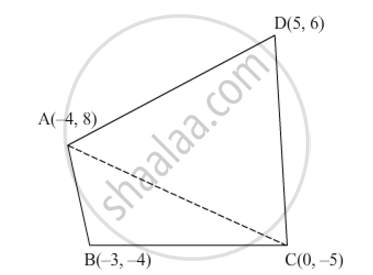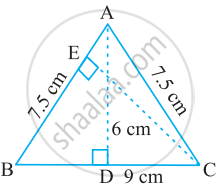Advertisements
Advertisements
प्रश्न
If A(−4, 8), B(−3, −4), C(0, −5) and D(5, 6) are the vertices of a quadrilateral ABCD, find its area.
उत्तर

Let the vertices of the quadrilateral be A(−4, 8), B(−3, −4), C(0, −5) and D(5, 6).
Join AC to form two triangles, namely, ΔABC and ΔACD.
Area of quadrilateral ABCD = Area of ΔABC + Area of ΔACD
We know
Area of triangle having vertices (x1, y1), (x2, y2) and (x3, y3) =`1/2`[x1(y2−y3)+x2(y3−y1)+x3(y1−y2)]
Now,
Area of ∆ABC=`1/2`{(−4)[(−4)−(−5)]+(−3)[(−5)−(8)]+(0)[(8)−(−4)]}
=`1/2`(−4+39)
`=35/2 `
Area of ∆ACD=`1/2`{(−4)[(−5)−(6)]+(0)[(6)−(8)]+(5)[(8)−(−5)]}
=`1/2`(44+65)
`=109/2`
∴Area of quadrilateral ABCD=Area of ∆ABC+Area of ∆ACD
`35/2+109/2`
=72 square units
Thus, the area of quadrilateral ABCD is 72 square units.
संबंधित प्रश्न
Find the values of k so that the area of the triangle with vertices (k + 1, 1), (4, -3) and (7, -k) is 6 sq. units.
A(4, - 6), B(3,- 2) and C(5, 2) are the vertices of a 8 ABC and AD is its median. Prove that the median AD divides Δ ABC into two triangles of equal areas.
The class X students of a secondary school in Krishinagar have been allotted a rectangular plot of land for their gardening activity. Saplings of Gulmohar are planted on the boundary at a distance of 1 m from each other. There is a triangular grassy lawn in the plot as shown in the following figure. The students are to sow seeds of flowering plants on the remaining area of the plot.

(i) Taking A as origin, find the coordinates of the vertices of the triangle.
(ii) What will be the coordinates of the vertices of Δ PQR if C is the origin?
Also calculate the areas of the triangles in these cases. What do you observe?
ΔABC is right angled at A (see the given figure). AD is perpendicular to BC. If AB = 5 cm, BC = 13 cm and AC = 12 cm, Find the area of ΔABC. Also find the length of AD.

ΔABC is isosceles with AB = AC = 7.5 cm and BC = 9 cm (see the given figure). The height AD from A to BC, is 6 cm. Find the area of ΔABC. What will be the height from C to AB i.e., CE?

Show that the points (-3, -3),(3,3) and C (-3 `sqrt(3) , 3 sqrt(3))` are the vertices of an equilateral triangle.
For what value of k(k>0) is the area of the triangle with vertices (-2, 5), (k, -4) and (2k+1, 10) equal to 53 square units?
Find the value of x for which points A(x, 2), B(-3, -4) and C(7, -5) are collinear.
Using integration, find the area of triangle ABC, whose vertices are A(2, 5), B(4, 7) and C(6, 2).
The value of the determinant `abs((1,"x","x"^3),(1,"y","y"^3),(1,"z","z"^3))` is ____________.
